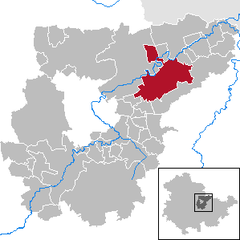Apolda
You can help expand this article with text translated from the corresponding article in German. (December 2012) Click [show] for important translation instructions.
|
Apolda | |
|---|---|
 | |
Location of Apolda within Weimarer Land district  | |
| Country | Germany |
| State | Thuringia |
| District | Weimarer Land |
| Government | |
| • Mayor | Rüdiger Eisenbrand |
| Area | |
| • Total | 46.15 km2 (17.82 sq mi) |
| Elevation | 205 m (673 ft) |
| Population (2022-12-31)[1] | |
| • Total | 23,072 |
| • Density | 500/km2 (1,300/sq mi) |
| Time zone | UTC+01:00 (CET) |
| • Summer (DST) | UTC+02:00 (CEST) |
| Postal codes | 99501-99510 |
| Dialling codes | 03644, 036462, 036465 |
| Vehicle registration | AP,APD |
| Website | www.apolda.de |
Apolda () is a town in central Thuringia, Germany, the capital of the Weimarer Land district. It is situated in the center of the triangle Weimar–Jena–Naumburg near the river Ilm, c. 15 kilometres (9 miles) east by north from Weimar, on the main line of railway from Berlin via Halle, to Frankfurt.
History
Apolda was first mentioned in 1119. Until 1633 it was seat of a family of nobles, the Vitzthums, which acted relatively independent. Between 1633 and World War I Apolda was property of Jena University. Nevertheless, from 1691 to 1809 Apolda was part of the Duchy of Saxe-Weimar and from 1809 to 1918 of Saxe-Weimar-Eisenach (after 1815 Grand Duchy). Around 1700, the knitting industry began to grow, so that finally, at the end of the 19th century, Apolda was the wealthiest town of the whole region. After World War II, Thuringia became part of the German Democratic Republic. Up to German reunification Apolda still was famous for its textile industries. Since then, a notable economic decay has taken place.
Mayors
Ernst Stegmann was the long-time mayor of Apolda with 33 years in office (1901-1934).
|
|
|
|
|
Main sights
It has few notable public buildings, but possesses three churches and monuments to the Dobermann Pinscher dog breed, which was created in Apolda, and to Christian Zimmermann (1759–1842), who, by introducing the hosiery and cloth manufacture, made Apolda one of the most important places in Germany in these branches of industry. It has also had extensive dyeworks, bell foundries, and manufactures of steam engines, boilers, cars and bicycles. After German reunification the majority of these had to be closed down for economical reasons.
The most important sights are:
- St. Martin's Church (1119), details in Romanesque, Gothic and Baroque style
- Town Hall (1558/9), in Renaissance style
- Castle (16th/17th century)
- Railway viaduct (1845/46)
- Zimmermann factory building (1880-2)
- Lutherkirche (1894)
- St. Boniface's Church (1894)
- Glocken museum (Bell museum)
The largest free hanging bell in the world, the Decke Pitter of Cologne Cathedral, was made in Apolda. Apolda also has mineral springs.
International relations
Twin towns – sister cities
Apolda is twinned with:
People
- Klaus Agthe (born 1930), German businessman and author
- Karl Friedrich Louis Dobermann (1834-1894), first breeder of the Doberman Pinscher
- Otto Franz Georg Schilling (1911-1973) mathematician
- Mike Mohring (born 1971), leader of the CDU faction Thüringen and since 1999 a member of the Thuringian Parliament
References
This article incorporates text from a publication now in the public domain: Chisholm, Hugh, ed. (1911). "Apolda". Encyclopædia Britannica (11th ed.). Cambridge University Press.


